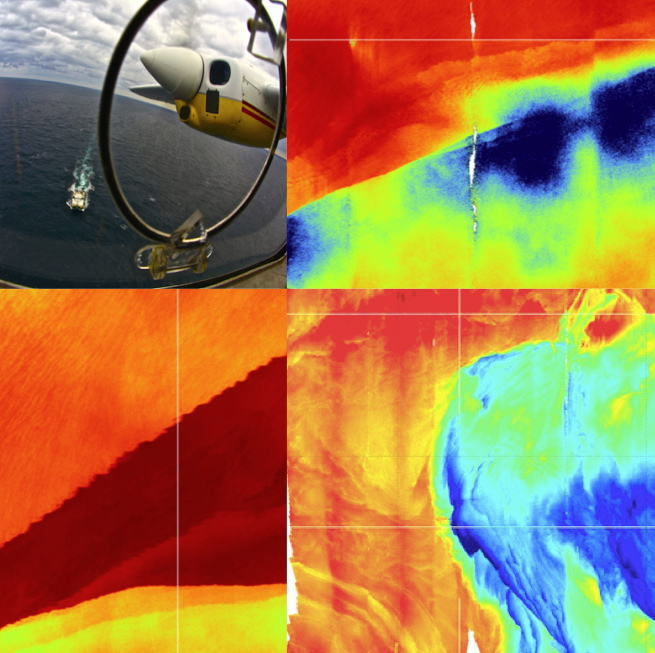Machine Learning for Submesoscale Characterization, Ocean Prediction, and Exploration (ML-SCOPE)
|
P.F.J. Lermusiaux, P.J. Haley, Jr., A. Babu, S. Mouzahir, R. Huang C. Mirabito Massachusetts Institute of Technology
|
Co-Principal Investigators: T. Broderick (MIT), L. Carin (Duke U.), E.P. Chassignet (FSU), M.D. Chekroun (UCLA), S. Jegelka (MIT), J.C. McWilliams (UCLA), T.M. Özgökmen (RSMAS - U. Miami) |
Project Summary Ongoing MIT-MSEAS Research Additional ML-SCOPE Links MSEAS ML-SCOPE-supported Publications Background Information
|

|
|
MURI ML-SCOPE Project Home Page
This research is sponsored by the Office of Naval Research. |
|||
Project Summary
Our collaborative long-term goal is to obtain machine-intelligent modeling systems that seamlessly integrate stochastic ocean dynamical models and their multi-fidelity representations with Bayesian and generative learning from data-model misfits, to construct improved ocean models with more accurate parameterizations and discover invariances or differential equations, over a range of spatial and temporal scales. We will use and vastly extend stochastic dynamic reduced-order methods, Bayesian GPs, adaptive DL schemes, and generative networks. Ultimately, our symbolic interpretation of ML models into emergent dynamical and constitutive relations would further compress knowledge relative to deep networks, thus extending outside the range of the training data.
Background information is available below.
| Top of page |
Ongoing MIT-MSEAS Research
Specific (Collaborative) Objectives:
- Learn from heterogeneous measured data sets, multi-resolution simulated fields from three ocean modeling systems, and data-assimilative simulations in several ocean regions and basins, and the global ocean
- Use and vastly extend hierarchical differential-equation-based Bayesian learning, stochastic dynamic reduced-order methods, data-driven closure models, Bayesian Gaussian Processes, adaptive DL schemes, and generative models and adversarial networks
- Obtain submesoscale ML super-parameterizations
- Develop ML for data assimilation and ML-based adaptive sampling to identify the most informative data for model learning
- Refine and incubate methods using idealized and semi-realistic test cases, and quantify and optimize their robustness, and verify ML results using novel metrics of success.
Publications
MSEAS ML-SCOPE-supported Publications
Awards
| Top of page |
Additional ML-SCOPE Links
- Ocean Modelling: Forthcoming Special Issue “Machine Learning for Ocean Modelling” (ScienceDirect.com by Elsevier)
- National Academies’ February 2022 Workshop:
| Top of page |
Background Information
The Multidisciplinary Simulation, Estimation, and Assimilation Systems (MSEAS) build on years of relocatable ocean modeling experience for physical, acoustical, and biogeochemical studies. The software is used for fundamental research and for realistic simulationsand forecasts of fields and uncertainties around the world’s oceans. Practical applications include ocean monitoring, real-time acoustic predictions and DA, biogeochemical-ecosystem predictions and environmental management, relocatable rapid response, path planning for autonomous vehicles, and adaptive sampling. MSEAS has been tested and validated in a wide range of real-time forecasting exercises. They include: AWACS and SW-06, AOSN-II and MB-06, QPE-08 and -09, PhilEx-08 and -09, and NASCar and FLEAT. Recently, we issued multi-resolution forecasts of 3D Lagrangian transports, coherent structures, and their uncertainties, and guided drifter releases for optimal Lagrangian sampling (NSF-ALPHA). Using ESSE, we used large-ensemble forecasts of high-resolution fields (sound-speed, currents, etc.) for 3D underwater-GPS exercises (POINT). MSEAS also includes finite-element codes for non-hydrostatic dynamics as well as a framework for stochastic 2D ocean and fluid flows and incubation of DA and ML methods. Our proposed research will leverage all of these efforts.
| Top of page |


